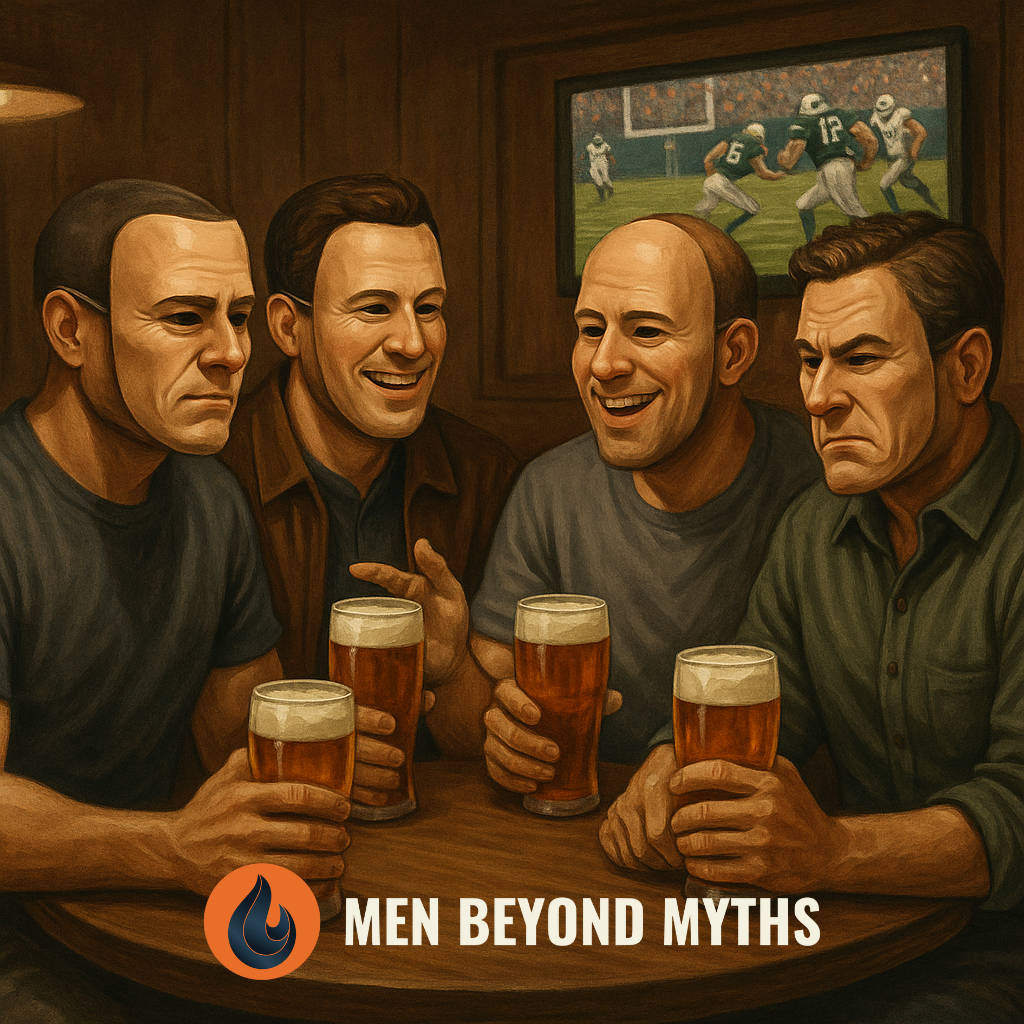A Halloween reflection on the masks men wear long after the costumes come off — and what it costs to keep pretending.
October ends with a kind of magic. Streets are lined with pumpkins, kids laugh behind plastic fangs.
Grown men step into costumes that make them feel, for one night, like someone else.
But when the night ends and the masks come off, what are we still hiding?
For most of us, the masks don’t come off when Halloween ends. We wear them every day. They’re invisible but heavy — the ones we put on to fit in, to look strong, to hide what we’re afraid might make us unlovable. These are the masks that keep us safe, but they also keep us separate.
Research shows that the majority of men feel pressure to hide their emotions — to stay strong, calm, and in control, even when they’re falling apart inside. The American Psychological Association notes that traditional masculine norms like stoicism and self-reliance are among the most significant barriers to men seeking help for mental health concerns (APA Guidelines for Boys and Men, 2018).
The costs are real: men account for roughly 75–80% of all suicide deaths worldwide (HeadsUpGuys, 2025), and in the U.S., men die by suicide at about four times the rate of women (Healthline, 2024). A 2024 systematic review found that conformity to masculine norms and self-stigma are two of the strongest predictors preventing young men from seeking help (PMC Study, 2024).
We’ve built a system that rewards emotional control and punishes openness — and it’s killing us.
The Everyday Masks
Men wear many kinds of masks.
The Tough Guy Mask that never cries.
The Breadwinner Mask that ties worth to a paycheck.
The Stoic Mask that trades emotional honesty for control.
The Relationship Escalator Mask that insists a good man follows a certain script — date, marry, settle down, stay the course.
The Inherited Mask that carries old family or cultural beliefs that no longer fit.
The Chameleon Mask that shifts to please everyone else — blending in, keeping the peace, and losing a little more of yourself each time.
The Fixer and Lone Wolf Masks that tell us we should solve everything alone.
Even the Sports Guy or Always-Right Mask — ways we signal belonging or dominance when we’re unsure how to just be ourselves.
The Chameleon Mask can feel like kindness — but underneath it, there’s often fear: fear of conflict, rejection, or being seen as “too much.”
These masks come from somewhere. Sometimes they’re taught. Sometimes they’re modeled. Sometimes they’re survival tools we learned early and just never took off.
The APA has documented that men who conform strongly to these traditional norms experience higher rates of anxiety, depression, and substance abuse — and are less likely to reach out for professional or peer support (APA Monitor, 2025).
But what happens when the mask starts to crack?
When the Mask Cracks
In the fall of 2021, I hit the lowest point of my life.
I was navigating divorce, drinking too much, and trying to hold myself together with a smile that didn’t match what was happening inside. I told myself I was fine — that I just needed to power through — but underneath, everything was unraveling.
I remember the date clearly — November 1. I’d been at a Halloween party the night before, surrounded by people wearing literal masks, and woke up the next morning realizing I’d been wearing my own for years.
That day, sitting in a coffee shop, my mind turned against me. I remember staring out the window, watching people go about their day, wondering how everyone else seemed fine. It was the first time I truly understood how frightening depression could be — when your own thoughts start to feel like an attack you can’t escape. I learned later that what I was experiencing had a name: suicidal ideation.
I made a safety plan, reached out for help, and told people I trusted what was going on. It was terrifying — but it kept me alive.
In the months that followed, I made choices that hurt people I cared about. The fallout forced me to face years of hidden shame, and I realized how many masks I’d been wearing — the strong man, the good husband, the dependable friend. I had spent so long pretending to be fine that I didn’t know who I was without those performances.
So I stopped hiding.
I wrote letters to the people who mattered most — owning everything, without excuses. It was one of the hardest things I’ve ever done, but also one of the most liberating. The truth was out. Some relationships didn’t survive it, but others became stronger and more real than they’d ever been.
When you live behind masks long enough, you start to forget what your own face looks like. Taking them off can feel like being exposed — but it’s also the first step toward freedom.
For me, unmasking wasn’t an act of rebellion; it was survival. It was choosing honesty over illusion. And it’s what saved my life.
Since then, embracing authenticity and showing up as my real self with integrity has allowed me to build new, deeper relationships — the kind I didn’t know were possible before. My romantic life and friendships are no longer hindered by fear or secrets. I’ve found partners who see the real me and have similar goals for their own relationships. I get to be real, unashamed, and fully seen.
And sometimes, it feels like a superpower — knowing that when you’ve already owned your truth, no one can use it against you. You take away the weapon before anyone can pick it up.
Every man I know wears some kind of mask. Some keep them on so long they forget they ever had a choice to take them off.
The Cost of Masks
Masks can protect us from rejection, but they also protect us from connection. They keep us safe from being hurt — and in doing so, they keep us alone. When we hide our fears, our failures, and our doubts, we also hide the parts of us that make real intimacy possible.
A 2021 Movember study found that 58% of men feel they can’t share their struggles because they fear judgment or appearing weak (Movember, 2021). Yet those who do open up report stronger relationships, better stress management, and improved well-being. Vulnerability, it turns out, isn’t weakness — it’s one of the strongest predictors of emotional resilience.
The truth is: most of us are craving connection, not performance. We just forget that sometimes the only way to be loved for who we are is to let ourselves be seen — flaws, cracks, and all.
That’s not weakness. That’s courage.
Reflection
If you’re reading this and it hits a little too close to home, take a breath. You’re not alone in this. Here are a few questions to sit with:
- When do you feel like you’re performing a version of yourself?
- What expectations shaped that mask?
- What would authenticity feel like in its place?
And if you ever find yourself in that kind of darkness — the kind that tells you you’re alone — please, reach out. Talk to someone. Let someone see you.
Because taking off the mask might be the hardest thing you ever do.
But it’s also where your life begins again.
What’s Next
This week, I’ll be sharing short reflections on each of the masks we wear — one every day.
Follow along as we explore how to recognize them, what they protect us from, and what freedom might look like without them.


